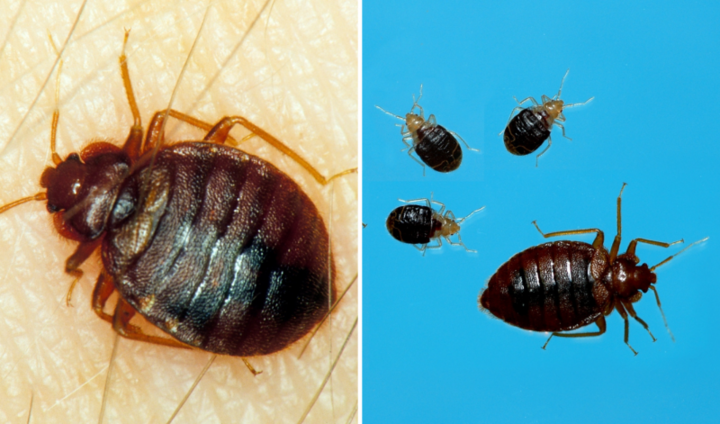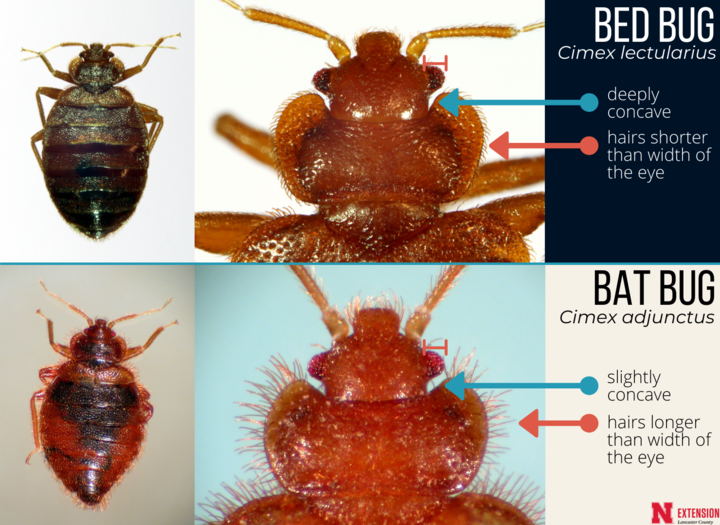Order: Hemiptera Family: Cimicidae

View our printable brochure, Preventing Bed Bug Infestations, in English, Spanish, and Vietnamese.
View our printable brochure, Dealing With Bed Bugs, in English, Spanish, and Vietnamese.
View our 2022 webinar, All About Bed Bugs: For Homeowners and Renters.
View our 2022 webinar, All About Bed Bugs: For Places of Business.
For information on bed bug control on a budget (the do-it-yourself approach) and control no longer on a budget (hiring someone), view our infographic in English, Arabic, Kurdish, Spanish, or Vietnamese.
- Bed bugs are small, wingless insects that infest homes and feed on blood.
- Bed bugs do not spread disease.
- Bed bugs are excellent hitchhikers on belongings and can hide behind outlet covers, picture frames, and in furniture.
- Some people are more sensitive to bites than others.
- Eradication of bed bugs can be difficult and challenging. Contacting a pest management professional is recommended.

Identification
Bed bug nymph (immature) with shed exoskeletons and black fecal marks. Photo provided by Jody Green.

Bed bugs are wingless, oval-shaped and small, with adults approximately the size of an apple seed (1/4” long). Unfed bed bugs are flattened and orange-red in color. Engorged (fed) bed bugs are a deep red and more elongated.
Signs of a bed bug infestation include:
- Live bugs
- Dead bugs
- Shed exoskeletons
- Black fecal marks
Some people may also notice the presence of bites. Reactions to bites differ from person to person: some may develop welts or bumps while others will have no reaction. A bed bug infestation cannot be diagnosed by the presence of bites alone. It’s also important to note that while bed bugs do bite, they do not spread disease.
Proper identification of a bed bug is essential before any management steps are taken. There are several species of closely-related bugs that appear similar to bed bugs but are managed differently. Bat bugs, for example, are commonly found in homes and are associated with their primary host: bats.
For questions regarding bed bug identification and management, contact experts in your state's Extension office.
Bed Bugs vs. Bat Bugs

How do I recognize bugs?
The first thing you should do if you find yourself in a situation with insects in your home is to have it properly identified by a professional. This is especially important with bed bugs and bat bugs, because to the average person, they can look indistinguishable and often require a microscope to tell the difference. Both bugs are covered with hair, but the bat bug has much longer hair, particularly behind the head on the part of the body called the pronotum. Additionally, while bed bugs can go for months without being noticed, bat bugs are strangely found out in the open, walking on furniture, along windowsills or on top of bed covers. In Lincoln, about half of all suspected bed bugs brought in the to Nebraska Extension in Lancaster County end up being bat bugs.
It's a BAT BUG: Now what?
While bat bugs may occasionally bite humans in the absence of their regular hosts (bats); controlling them is a lot simpler than controlling bed bugs. Fixing your bat bug problem is as simple as removing any bats roosting in or around your home. Contact your local pest control specialist for safe relocation and vacuum up any lingering bugs around the home. Voila — your bat bug problem is solved! There is usually no need to treat bedrooms, beds or other sleeping areas with insecticides if the bats are eliminated.
Life Cycle
Bed bugs undergo gradual metamorphosis and have three life stage: egg, nymph (immature) and adult. All bed bugs require a blood meal to molt (shed their exoskeleton) and grow; adult females also require a blood meal to produce eggs. Bed bug eggs are approximately the size of poppy seed (1/16” long), white in color, and are often found in cracks and crevices such as the seams of a mattress. A single female may produce up to 250 eggs in her lifetime. Once hatched, bed bug nymphs molt five times before they reach adulthood. In some circumstances, bed bugs can survive for up to a year without a blood meal. Thus, putting items in storage and trying to starve them out is not recommended.

Management
If you suspect you have bed bugs, a thorough inspection is needed. Look for signs of bed bugs including live bugs, dead bugs, shed exoskeletons, and black fecal stains. Begin your inspection by checking for bed bugs in cracks and crevices around areas where people sleep or spend most of their time. Pay particular attention to fabric seams, folds and zippers.
Because bed bugs are difficult to eradicate, contacting a pest management professional is recommended. The majority of bed bug treatments require at least two visits or applications to kill any bugs that have recently hatched or survived the initial application. Monitor for bed bugs over the course of 6-8 months after the original treatment, and consider contacting a professional for help if a persistent infestation occurs.
Prevention
Content provided by Jody Green.
Bed bugs locate their hosts by detecting carbon dioxide and secretively crawl into human belongings to hitchhike to different locations. Bed bugs can be found anywhere people go and they do not discriminate: they can affect individuals, families and communities regardless of cleanliness, ethnic group, race, age or socioeconomic status.
There are several preventative actions you can take at home to minimize your risk of a bed bug infestation:
- Reduce clutter to minimize hiding spots,
- Regularly change, inspect and launder bedding,
- Do not bring home used or free furniture,
- Use light-colored sheets or use mattress encasements for quick and easy detection,
- Vacuum and inspect upholstered furniture,
- Store items like bedding and luggage in plastic totes to isolate rom bed bugs,
- Monitor for bed bugs using pitfall traps/interceptors under furniture legs,
- Communicate to friends and family members about bed bugs to avoid transferring them during visits, holiday travel, and vacations.
When traveling, it’s important to inspect your hotel room for signs of bed bugs. Use a flashlight when pulling back bedding from box spring and examine seams, corners, folds, tags, etc. You should also refrain from putting your luggage on the bed or floor. Instead, place luggage on a hard surface such as the bathroom counter or in a bath tub. Bag and isolate any dirty laundry that accumulates during the trip. Bed bugs are attracted to the human scent and prefer dirt clothes rather than clean.
If you do find a bed bug while traveling, collect it and alert management right away.
Upon returning home from a trip:
- Unpack luggage outside or in the garage
- Take clothes directly to the clothes dryer; run the dryer on high heat for at least 20-30 minutes
- Inspect all items before bringing them indoors including
- Outerwear
- Shoes
- Purses
- Backpacks
- Luggage
- Vacuum or wipe down luggage before storing them in an area where nobody sleeps like a garage, basement, or storage area.
Non-Chemical Management Strategies
Effective management of bed bugs often combines non-chemical and chemical treatment options. Whether you choose the do-it-yourself approach or hire a pest management professional, there are several things you can do to reduce or eradicate bed bug populations in your home.
Due to the emergence of insecticide-resistant bed bugs, non-chemical treatments should be one of the first options utilized. Some insecticide-free management methods include:
- Installing special mattress encasements on mattresses and box springs
- Using bed bug interceptor devices under furniture legs and pulling furniture several inches away from the wall
- Vacuuming cracks and crevices and immediately discarding contents
- Using extreme temperature treatments to kill bugs and eggs by:
- Placing fabric items in a clothes dryer on high heat (120°F) for at least 30 minutes
- Bagging small items and placing them in a freezer (0°F) for at least 4 days
- Slowly steam-treating upholstered furniture with a commercial portable steam unit
Pest control companies may also offer whole structural heat treatments using commercial heating units and thermal monitoring. Heat treatments typically take 6-8 hours to complete and bring infested spaces up to lethal temperatures that kill all life stages.
Because these non-chemical treatments provide no residual effects, they should be used in combination with insecticidal treatments for a longer-term solution.
Chemical Management Strategies
There are many different insecticides available for bed bug control, with the majority being pyrethroids. However, the use of a management plan utilizing multiple active ingredients or modes-of-action (classes) is highly recommended due to the emergence of insecticide resistance in bed bug populations.
For cracks, crevices and wall voids
Residual insecticides (insecticides that last past initial application) in the form of dusts or liquid sprays are recommended for use in cracks, crevices and wall voids, all of which are areas bed bugs commonly aggregate when not actively feeding. Liquid sprays re generally applied to baseboards, ceiling-wall junctions, and other cracks and crevices. Dust formulations are applied to wall voids behind wall outlets and under baseboards. Common dusts used are diatomaceous earth and silica dust, the latter of which has shown to be more effective in bed bug control.
For beds, box springs and other furniture
Contact insecticidal sprays in the form of aerosols are most commonly applied to areas with frequent human contact such as mattresses, box springs and other furniture. Look for formulations that combine at least two modes-of-action or active ingredients such as cyfluthrin + imidaclroprid or resmethrin + imidacloprid.
For small items that cannot be heat or cold treated
Occasionally, there will be bed bug-infested infested items that are too sensitive for a heat treatment and are unable to be cold-treated (i.e. no room in the freezer!) For items such as these, the use of 18.6% dichorvos, or DDVP, strips may be useful. Items can be placed in air-tight containers or plastic bags with a DDVP strip, which will volatize and kill bed bugs and eggs. It is important to note, however, that it can take up to 2 weeks for DDVP strips to kill 100% of bed bugs. As with all insecticides, read and follow the label directions before use.
Fumigants and Foggers
Some pest management companies may offer fumigation services for bed bug management. Although costly, home fumigation is one of the most effective chemical controls for bed bugs. While fumigation is effective in killing all stages of the bed bug, the use of total release foggers, is not. Over-the-counter pyrethroid foggers are ineffective against bed bugs and may leave behind dangerous residues. Thus, the use of foggers is not recommended.
Reference to commercial products or trade names is made with the understanding that no discrimination is intended and no endorsement by the University of Nebraska–Lincoln is implied. The information on this Web site is valid for residents of southeastern Nebraska. It may or may not apply in your area.
Authors:
Kait Chapman, M.S., Urban Entomology Extension Educator, Nebraska Extension in Lancaster County
Jody Green, Ph.D., Urban Entomology Extension Educator, Nebraska Extension in Douglas-Sarpy Counties